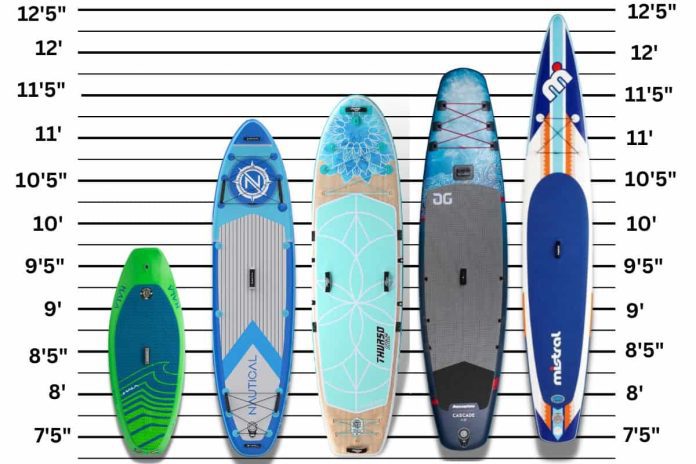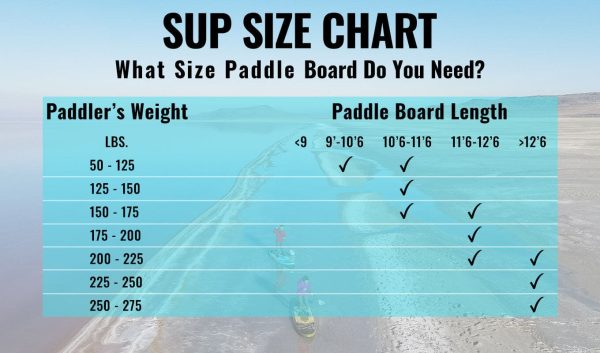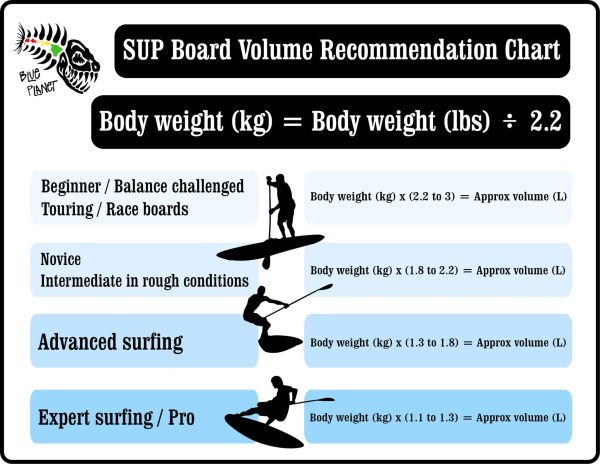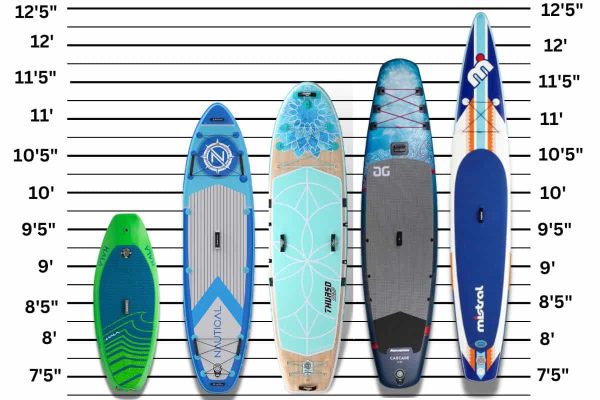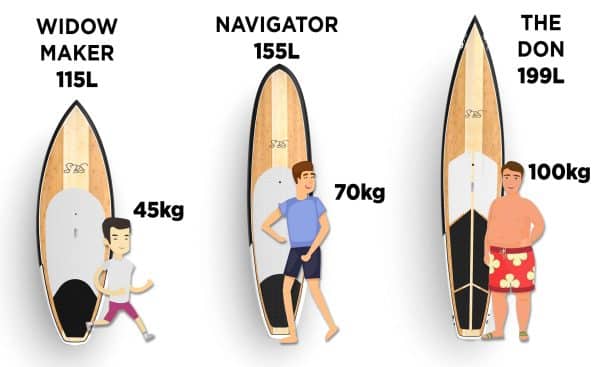Choosing the perfect SUP board can feel daunting, especially with many sizes and options available. But fear not, dear reader, for we are here to guide you through the process!
This article will explore the factors you must consider when selecting the proper size SUP board for your weight and skill level.
Whether you are a beginner, intermediate, or advanced paddler, we’ll help you find the ideal board to make your stand-up paddleboarding experience all the more enjoyable.
So, let’s embark on this journey together and discover the perfect SUP board that suits you like a glove!
Factors to Consider
Choosing the suitable SUP (Stand-Up Paddle) board involves considering various factors, such as weight, skill level, intended use, and paddling conditions. Each factor is crucial in determining the ideal size and type of board for you. This article will explore these factors to help you make an informed decision and find the perfect SUP board that suits your needs and preferences.
Weight
The first factor to consider when choosing a SUP board is your weight. It directly affects the board’s stability and performance on the water. Generally, the more weight a board has to support, the larger it must be to maintain stability and ensure a great paddling experience.
Weight and Board Volume
Board volume is a critical measurement determining how much weight the board can support while maintaining stability. Volume is usually measured in liters and indicates the board’s buoyancy. The higher the volume, the more weight the board can support without sinking.
Calculating the Right Volume
To calculate the right volume for your SUP board, consider your weight, skill level, and intended use. There are online volume calculators that can help you determine the ideal volume based on these factors. Choosing a board with a slightly higher volume than the calculated figure is always best to ensure maximum stability and performance.
Weight and Stability
When it comes to stability, it is essential to find a SUP board that offers ample stability for your weight. A stable board allows you to maintain balance easily, especially if you are a beginner or carrying additional equipment such as fishing gear. Heavier individuals may benefit from more comprehensive, longer boards with higher volumes, as these provide better stability and prevent the board from sinking under the weight.
This image is the property of cdn.shopify.com.
Skill Level
Your skill level is another crucial factor when choosing a SUP board. Whether you are a beginner, intermediate, or advanced paddler, the board’s dimensions and characteristics can significantly impact your overall experience on the water.
Beginner
For beginners, choosing a broader and more stable board is recommended. These boards provide stability and balance, making learning and developing paddling skills easier. A wider board also offers more room for error and helps minimize the chances of falling off.
Intermediate
Intermediate paddlers have developed essential skills and are looking to progress further. They can consider a slightly narrower board that offers better maneuverability without compromising stability. As they gain more experience and confidence, they can explore boards with more specialized features for specific activities.
Advanced
Advanced paddlers possess a high level of skill and experience. They can opt for narrower and more performance-oriented boards. These boards are designed for speed, agility, and maneuverability, allowing advanced paddlers to maximize their skills and explore various water conditions.
Board Type
Choosing the right board type is crucial to ensure an enjoyable paddling experience. Each board type has unique features and characteristics, catering to different activities and preferences.
All-around
All-around SUP boards are versatile and suitable for various activities, including recreational paddling, yoga, and light surfing. They balance stability, maneuverability, and speed well, making them an excellent choice for beginners and intermediate paddlers seeking a multi-purpose board.
Touring
Touring boards are designed for long-distance paddling and exploring different water environments. They typically have a longer length, narrower shape, and increased hull speed for efficient and enjoyable touring experiences. These boards excel in flatwater conditions and are ideal for intermediate to advanced paddlers who enjoy exploring lakes, rivers, or coastlines.
Surf
Surf SUP boards are specifically designed for riding waves. They are shorter, narrower, and have more excellent rocker, allowing them to maneuver quickly on the face of the wave. Surf SUP boards are ideal for experienced paddlers looking for an adrenaline-filled surfing experience.
Racing
Racing SUP boards are built for speed and performance in competitions or high-intensity paddling scenarios. These boards are longer, narrower, and often feature a displacement hull, allowing them to slice through the water with minimal resistance. Racing SUP boards are designed for advanced paddlers who have honed their skills and seek to compete or excel in challenging racing conditions.
Yoga
Yoga SUP boards have a comprehensive and stable platform designed to accommodate yoga and fitness activities on the water. These boards often feature additional deck padding for comfort and traction, allowing yogis to practice their poses and balance easily.
Fishing
Fishing SUP boards are specially designed to accommodate anglers and their gear. They typically have a comprehensive and stable platform, with ample space for attaching fishing accessories such as rod holders, coolers, and tackle storage. These boards give anglers a unique perspective on fishing and allow them to access remote fishing spots that may not be accessible by traditional means.
This image is the property of cdn.shoplightspeed.com.
Board Length
The length of a SUP board plays a crucial role in determining its stability, maneuverability, and overall performance on the water. Consider the following factors related to board length when making your decision.
Length and Stability
More SUP boards generally provide better stability due to their increased waterline. A longer board is recommended if you are a beginner or prefer a stable experience. Longer boards are also ideal for touring, where stability and tracking are essential.
Length and Maneuverability
Shorter SUP boards offer improved maneuverability, ideal for quick turns, surfing waves, or tight spaces. They are suitable for more experienced paddlers prioritizing agility and responsiveness over stability.
Length and Performance
The length of a SUP board also affects its overall performance. Longer boards tend to excel in flatwater conditions and provide better gliding capabilities. They are often favored by fitness paddlers, racers, and those seeking maximum stroke efficiency. On the other hand, shorter boards are more maneuverable and suitable for surfing or river paddling.
Board Width
The width of a SUP board determines its stability, speed, and maneuverability. Consider the following factors related to board width when choosing your SUP.
Width and Stability
Wider SUP boards offer more stability, making them ideal for beginners, families, or individuals who prefer a leisurely paddling experience. These boards provide greater security and balance, minimizing the chances of tipping over.
Width and Speed
Narrower SUP boards offer higher speeds due to reduced resistance in the water. They are typically favored by more experienced paddlers or those focused on fitness and performance-oriented paddling. With a narrower width, these boards cut through the water efficiently, allowing faster speeds and smoother gliding.
Width and Maneuverability
Wider SUP boards have better maneuverability, providing a larger surface area to pivot and turn. This makes them more suitable for activities such as yoga, fishing, or recreational paddling, where stability and maneuverability are essential. Narrower boards, while faster, may require more skill and technique to maneuver effectively, particularly in tight or challenging spaces.
This image is the property of www.watersportswhiz.com.
Board Thickness
The thickness of a SUP board influences its stability, weight, and overall performance. Consider the following factors related to board thickness when selecting your SUP.
Thickness and Stability
Thicker SUP boards generally offer better stability than thinner boards. A thicker board’s additional volume and buoyancy contribute to a more stable paddling experience, particularly for beginners or individuals with higher weights.
Thickness and Weight
Thicker SUP boards tend to be heavier than thinner boards due to additional materials used to achieve the desired thickness. Consider your strength and ability to carry and transport the board, especially if you plan to use it independently or must navigate challenging terrain to access the water.
Thickness and Performance
Thinner SUP boards are often favored by more experienced paddlers who prioritize performance and maneuverability. A thinner board allows for better control and responsiveness, particularly in challenging water conditions or when executing advanced techniques and maneuvers.
Board Shape
The shape of a SUP board, including its rocker, nose shape, tail shape, and outline shape, significantly impacts its overall performance and suitability for different activities.
Rocker
Rocker refers to the curvature of the board from nose to tail. A more pronounced rocker allows for better maneuverability and wave performance, as the board can “rock” on the curved surface. However, a flatter rocker provides better tracking and speed in flatwater conditions. Consider the type of water conditions you will be paddling in when choosing the appropriate rocker.
Nose Shape
Different nose shapes serve various purposes. A pointed or narrow nose provides better maneuverability and wave performance, making it ideal for surfing or more advanced paddlers. A round or wider nose offers better stability and buoyancy in water, making it suitable for beginners, recreational paddling, or touring.
Tail Shape
Tail shape affects maneuverability and stability. A wider tail provides better stability, while a narrower tail improves maneuverability. Wider tails are suitable for activities like yoga, fishing, or family paddling, where stability is essential. Narrower tails are preferred for surfing, river paddling, or experienced paddlers seeking greater agility and responsiveness.
Outline Shape
The overall outline shape of a SUP board, including its width and length proportion, affects stability, performance, and paddling experience. Some boards have a more parallel outline, which helps track and speed in flat water. Others have a more rounded or fish-shaped outline, which provides better maneuverability and response in waves or river conditions. Consider your primary paddling activities to determine the most suitable outline shape.
This image is the property of sbsboards.com.
Additional Features
SUP boards often have additional features that enhance the paddling experience and cater to specific activities or preferences. Consider the following additional features when choosing your SUP board.
Deck Padding
Deck padding refers to the cushioned surface on top of the SUP board. It provides comfort and traction, making it easier to maintain balance. Deck padding is essential for yoga enthusiasts or anyone who spends extended periods on the board.
Fin Setup
The fin setup on a SUP board affects tracking, stability, and maneuverability. Boards can have a single fin, two side fins, or multiple fins in different configurations. Consider the paddling you will be doing and choose a fin setup that complements your objectives and preferences.
Carry Handles
Carry handles on a SUP board make transporting and maneuvering the board on land easier. They should be well-positioned, comfortable, and sturdy to ensure effortless transportation.
Bungee Systems
Bungee systems are elastic cords or nets on the board’s surface, typically at the front and back. They provide storage space for securing dry bags, coolers, or gear during your paddling adventures. Bungee systems are helpful for touring, fishing, or carrying additional equipment.
GoPro Mounts
GoPro mounts can attach an action camera to your SUP board, allowing you to capture epic paddling moments or share your experiences with others. If you enjoy documenting your adventures or sharing them on social media, GoPro mounts can be a valuable addition.
Summary of Additional Features
The overall combination of additional features will depend on your specific needs and preferences. Consider what activities you will primarily engage in and choose a board with additional features to enhance your paddling experience.
Conclusion
Choosing the right size SUP board requires careful consideration of several factors, including weight, skill level, intended use, and paddling conditions. By assessing these factors, you can determine the ideal volume, length, width, thickness, shape, and additional features that suit your needs and preferences.
Consider your skill level and select a board that aligns with your abilities and allows growth and progression.
By evaluating these factors, you can find the perfect SUP board that offers an enjoyable and rewarding paddling experience. So, grab your paddle, hit the water, and have a fantastic time exploring the beautiful world of SUP!
This image is the property of cdn.shoplightspeed.com.

